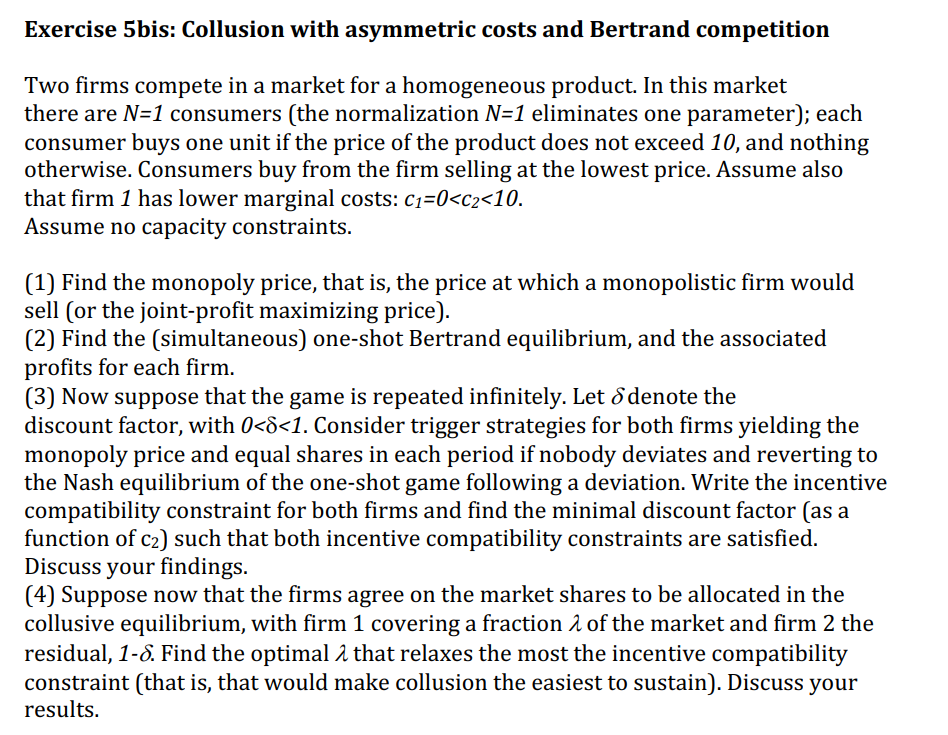Exercise 5bis: Collusion with asymmetric costs and Bertrand competition Two firms compete in a market for a homogeneous product. In this market there are N=1 consumers (the normalization N=1 eliminates one parameter); each consumer buys one unit if the price of the product does not exceed 10, and nothing otherwise. Consumers buy from the firm selling at the lowest price. Assume also that firm 1 has lower marginal costs: c1=0
Exercise 5bis: Collusion with asymmetric costs and Bertrand competition Two firms compete in a market for a homogeneous product. In this market there are N=1 consumers (the normalization N=1 eliminates one parameter); each consumer buys one unit if the price of the product does not exceed 10, and nothing otherwise. Consumers buy from the firm selling at the lowest price. Assume also that firm 1 has lower marginal costs: c1=0
Managerial Economics: A Problem Solving Approach
5th Edition
ISBN:9781337106665
Author:Luke M. Froeb, Brian T. McCann, Michael R. Ward, Mike Shor
Publisher:Luke M. Froeb, Brian T. McCann, Michael R. Ward, Mike Shor
Chapter16: Bargaining
Section: Chapter Questions
Problem 16.1IP
Related questions
Question

Transcribed Image Text:Exercise 5bis: Collusion with asymmetric costs and Bertrand competition
Two firms compete in a market for a homogeneous product. In this market
there are N=1 consumers (the normalization N=1 eliminates one parameter); each
consumer buys one unit if the price of the product does not exceed 10, and nothing
otherwise. Consumers buy from the firm selling at the lowest price. Assume also
that firm 1 has lower marginal costs: c1=0<c2<10.
Assume no capacity constraints.
(1) Find the monopoly price, that is, the price at which a monopolistic firm would
sell (or the joint-profit maximizing price).
(2) Find the (simultaneous) one-shot Bertrand equilibrium, and the associated
profits for each firm.
(3) Now suppose that the game is repeated infinitely. Let d denote the
discount factor, with 0<8<1. Consider trigger strategies for both firms yielding the
monopoly price and equal shares in each period if nobody deviates and reverting to
the Nash equilibrium of the one-shot game following a deviation. Write the incentive
compatibility constraint for both firms and find the minimal discount factor (as a
function of c2) such that both incentive compatibility constraints are satisfied.
Discuss your findings.
(4) Suppose now that the firms agree on the market shares to be allocated in the
collusive equilibrium, with firm 1 covering a fraction 2 of the market and firm 2 the
residual, 1-8. Find the optimal 2 that relaxes the most the incentive compatibility
constraint (that is, that would make collusion the easiest to sustain). Discuss your
results.
Expert Solution
This question has been solved!
Explore an expertly crafted, step-by-step solution for a thorough understanding of key concepts.
Step by step
Solved in 2 steps

Knowledge Booster
Learn more about
Need a deep-dive on the concept behind this application? Look no further. Learn more about this topic, economics and related others by exploring similar questions and additional content below.Recommended textbooks for you

Managerial Economics: A Problem Solving Approach
Economics
ISBN:
9781337106665
Author:
Luke M. Froeb, Brian T. McCann, Michael R. Ward, Mike Shor
Publisher:
Cengage Learning


Managerial Economics: A Problem Solving Approach
Economics
ISBN:
9781337106665
Author:
Luke M. Froeb, Brian T. McCann, Michael R. Ward, Mike Shor
Publisher:
Cengage Learning
